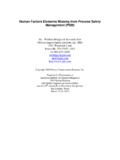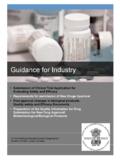Transcription of RESPONSIBLE CARE PRODUCT SAFETY CODE OF …
1 RESPONSIBLE care . PRODUCT SAFETY code OF management practices . Purpose and Scope Chemistry is a source of innovation that creates a healthier, safer and more sustainable future. From solar cells, wind turbines and rechargeable batteries to air filters, water purifiers and disinfectants, chemistry enables us to save energy, reduce pollution and enhance public health. The American Chemistry Council's (ACC) RESPONSIBLE care companies manufacture a broad array of chemical products, ranging from commodity industrial chemicals used to make other chemical products, to specialty chemicals tailored for unique applications and formulations, to finished goods and consumer products.
2 PRODUCT SAFETY and stewardship are shared value chain responsibilities, as each company, depending upon its position in the chemical value chain, has a distinct and essential role to play. At each stage in the value chain, protecting public health, SAFETY , and the environment must be embraced as a core value, as it is by chemical manufacturers. ACC RESPONSIBLE care companies are committed to making innovative chemical products that can be used safely for their intended purposes. As part of this commitment, ACC and its members created this RESPONSIBLE care PRODUCT SAFETY code , which sets forth a set of practices to manage chemical PRODUCT SAFETY as part of our industry's signature health, SAFETY , security, and environmental management system.
3 The code reinforces RESPONSIBLE care 's legacy of PRODUCT stewardship that goes beyond regulatory requirements, which has been a central tenet of the program since its inception. The RESPONSIBLE care PRODUCT SAFETY code provides a comprehensive framework to drive continuous improvement in chemical PRODUCT SAFETY and stewardship. Implementation of this PRODUCT SAFETY code is mandatory for all ACC RESPONSIBLE care companies. management practices The PRODUCT SAFETY code requires that companies include PRODUCT SAFETY and stewardship as part of their management systems. PRODUCT SAFETY management requires an understanding of intended PRODUCT uses, a science-based assessment of potential risks from products, and consideration of the opportunities to manage PRODUCT SAFETY along the value chain.
4 A key component of managing PRODUCT SAFETY by parties in the value chain is exchanging information regarding PRODUCT hazards, intended uses, handling practices , exposures and risks. PRODUCT stewardship is the responsibility to understand, manage and communicate the health and environmental impacts of chemical products. Taken together, implementation of the following management practices enables chemical manufacturers to systematically evaluate, demonstrate and continuously improve their PRODUCT SAFETY performance, while also enhancing communication about important factors that can influence PRODUCT SAFETY throughout the value chain.
5 Each RESPONSIBLE care company's management system will include the following PRODUCT SAFETY and stewardship management practices : November 9, 2012, as approved by ACC Board of Directors 1. Leadership Commitment. Senior leadership commitment to a culture of PRODUCT SAFETY and stewardship. Each company's senior leadership demonstrates clear commitment through their words, policies and actions throughout their organization and in external communications. Senior leaders drive continuous improvement of PRODUCT SAFETY and stewardship through published policies, active participation and communication concerning PRODUCT SAFETY , establishing, tracking/reporting of objectives and goals, and providing sufficient and qualified resources.
6 Senior leadership is charged with evaluating the effectiveness of PRODUCT SAFETY programs and providing active support to drive improvement. 2. Accountability and management . Clearly established organizational accountability for PRODUCT SAFETY and stewardship. PRODUCT SAFETY and stewardship are integral to business processes and employee expectations. PRODUCT SAFETY and stewardship are core values that permeate each company's operations and functional responsibilities. PRODUCT SAFETY and stewardship responsibilities of employees are understood, including those roles that engage with suppliers, customers, contract manufacturers, carriers, distributors, contractors and third-party logistics providers.
7 Employees assigned these roles are informed and held accountable for their performance. 3. Prioritization of products. A risk-based process that considers available hazard and exposure information to prioritize products in need of further evaluation. Companies have a process in place to prioritize their products to identify those that require a more detailed evaluation, assessment, and risk management controls, as well as those that require additional data and information gathering. Companies apply a science- and risk- based approach, considering hazard, intended uses and exposure potential when they prioritize their products.
8 Companies include criteria that are applied uniformly to all products screened and that incorporate relevant, credible scientific advances and consider significant new information to ensure that prioritization decisions remain current. 4. PRODUCT information. A process to develop and maintain information on SAFETY , health and environmental hazards, intended uses and exposures for new and existing products to support risk characterization and PRODUCT SAFETY management . Companies consider the results of their risk-based prioritization process when gathering and developing information that is used in their risk evaluations, characterizations, and consideration of PRODUCT SAFETY management actions.
9 Companies evaluate existing information and appropriate assessment techniques, such as ACC's science policies and principles, to determine when additional information on hazards, intended uses, and exposures is needed. 5. Risk characterization. A process for the characterization of PRODUCT risks based on information collected on hazards, intended uses, and exposures associated with the stages of November 9, 2012, as approved by ACC Board of Directors a PRODUCT 's lifecycle. Companies characterize the potential risks of their products using an iterative, tiered process that considers prioritization results and may identify needs for additional hazard, use and exposure information.
10 Risk characterizations include consideration of information about downstream uses and reasonably anticipated exposures, including potential exposures to children. Risk characterizations use valid, reliable and relevant scientific studies and information, giving such studies and information appropriate weight, to determine potential risks associated with relevant levels of exposure under expected conditions of use. 6. PRODUCT SAFETY management . A process to identify, implement, document and communicate health, SAFETY and environmental measures to manage risk so that products can be safely used for their intended purposes.



